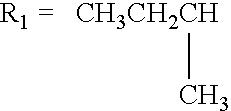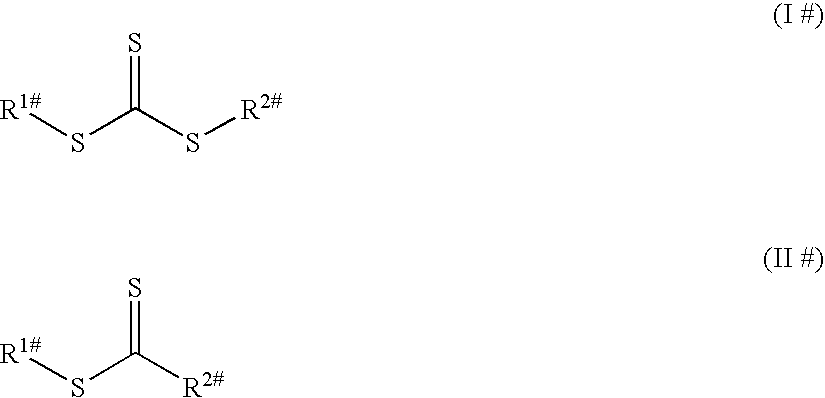Use of macromonomers to prepare acrylic PSAs
a macromonomer and acrylic technology, applied in the direction of adhesive types, graft polymer adhesives, coatings, etc., can solve the problems of imposing stringent requirements on adhesives and slowing down orientation
- Summary
- Abstract
- Description
- Claims
- Application Information
AI Technical Summary
Benefits of technology
Problems solved by technology
Method used
Image
Examples
example 1
[0178]A 10 L reactor conventional for radical polymerizations was charged with 60 g of acrylic acid, 1.62 kg of 2-ethylhexyl acrylate, 200 g of Chemlink® 4500 Macromer™, 120 g of N-isopropylacrylamide and 500 g of ethyl acetate. After nitrogen gas had been passed through the reactor for 45 minutes with stirring, the reactor was heated to 70° C. and 0.6 g of 2,2′-azoisobutyronitrile (AIBN) in solution in 30 g of ethyl acetate was added. The external heating bath was then heated to 70° C. and the reaction was carried out constantly at this external temperature. After a reaction time of 60 minutes, 0.2 g of Vazo 52® from DuPont in solution in 10 g of ethyl acetate was added. After a reaction time of 90 minutes, a further 0.2 g of Vazo 52® from DuPont in solution in 10 g of ethyl acetate was added, and, after a reaction time of 2 hours, 0.4 g of Vazo 52® from DuPont in solution in 200 g of ethyl acetate was added. After 3 hours, 1.2 g of 2,2′-azoisobutyronitrile (AIBN) in solution in 30...
example 2
[0179]A 10 L reactor conventional for radical polymerizations was charged with 120 g of acrylic acid, 1.68 kg of 2-ethylhexyl acrylate, 200 g of Chemlink® 4500 Macromer™ and 500 g of ethyl acetate. After nitrogen gas had been passed through the reactor for 45 minutes with stirring, the reactor was heated to 70° C. and 0.6 g of 2,2′-azoisobutyronitrile (AIBN) in solution in 30 g of ethyl acetate was added. The external heating bath was then heated to 70° C. and the reaction was carried out constantly at this external temperature. After a reaction time of 60 minutes, 0.2 g of Vazo 52® from DuPont in solution in 10 g of ethyl acetate was added. After a reaction time of 2 hours, 0.4 g of Vazo 52® from DuPont in solution in 200 g of ethyl acetate was added. After 3 hours, 1.2 g of 2,2′-azoisobutyronitrile (AIBN) in solution in 30 g of ethyl acetate were added. After 5 hours, the reaction mixture was diluted with 400 g of ethyl acetate. After periods of 5, 6, and 7 hours, portions each of...
example 3
[0180]A 10 L reactor conventional for radical polymerizations was charged with 30 g of acrylic acid, 1.77 kg of 2-ethylhexyl acrylate, 200 g of Chemlink® 4500 Macromer™ and 500 g of ethyl acetate. After nitrogen gas had been passed through the reactor for 45 minutes with stirring, the reactor was heated to 70° C. and 0.6 g of 2,2′-azoisobutyronitrile (AIBN) in solution in 30 g of ethyl acetate was added. The external heating bath was then heated to 70° C. and the reaction was carried out constantly at this external temperature. After a reaction time of 60 minutes, 0.2 g of Vazo 52® from DuPont in solution in 10 g of ethyl acetate was added. After a reaction time of 2 hours, 0.4 g of Vazo 52® from DuPont in solution in 200 g of ethyl acetate was added. After 3 hours, 1.2 g of 2,2′-azoisobutyronitrile (AIBN) in solution in 30 g of ethyl acetate were added. After 5 hours, the reaction mixture was diluted with 400 g of ethyl acetate. After periods of 5, 6, and 7 hours, portions each of ...
PUM
| Property | Measurement | Unit |
|---|---|---|
| glass transition temperature | aaaaa | aaaaa |
| weight fractions | aaaaa | aaaaa |
| weight fractions | aaaaa | aaaaa |
Abstract
Description
Claims
Application Information
 Login to View More
Login to View More - R&D
- Intellectual Property
- Life Sciences
- Materials
- Tech Scout
- Unparalleled Data Quality
- Higher Quality Content
- 60% Fewer Hallucinations
Browse by: Latest US Patents, China's latest patents, Technical Efficacy Thesaurus, Application Domain, Technology Topic, Popular Technical Reports.
© 2025 PatSnap. All rights reserved.Legal|Privacy policy|Modern Slavery Act Transparency Statement|Sitemap|About US| Contact US: help@patsnap.com



